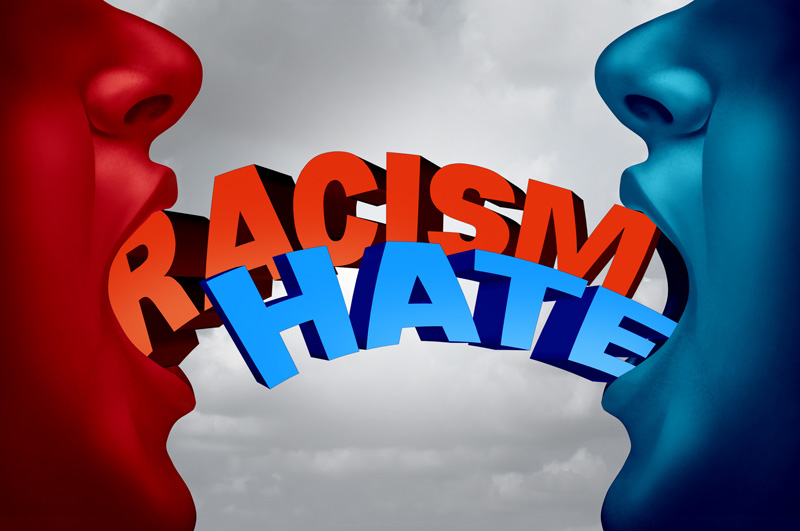Are Racial and Ethnic Hatred, Hate Crimes on the Rise in U.S.?
Racial and ethnic hate crimes – both inter-personal expressions of hate and acts of violence – is on the rise, along with deepening political polarization, distrust of civic institutions, widening racial, ethnic and class divides. In California, the State Legislature has just launched an initiative called “Stop the Hate” to support nonprofits and ethnic media working to address the issue. But what is hate, how do we measure it, when is hate a crime and can we stop it, even heal it?

At an Ethnic Media Services briefing, Aug. 19, speakers – Manjusha Kulkarni, Director and Co-founder of Stop AAPI Hate; Becky L. Monroe, Deputy Director for Strategic Initiatives and External Affairs, California Civil Rights Department; Sassana Yee, transformational justice activist for victims of hate crimes; and Brian Levin, Director, Center for the Study of Hate and Extremism, Cal State San Bernadino – addressed these issues.
Becky L. Monroe from California Civil Rights Department said, “Hate does not happen in a vacuum, so as the Civil Rights Department, we enforce other anti-discrimination provisions.
“We are already in the business of combating discrimination in employment, housing, public accommodations, businesses, and we recognize that if we’re truly going to address hate incidents and hate-crimes, we must make sure we are enforcing all of our civil rights protections.
“Our approach centers on survivors, victims of hate crimes, and recognizing that while some may want to go to law enforcement to seek additional support, for many that does not feel like a safe option, and so we are providing other options as well.
“When people talk about a hate crime, the basic definition under California Law is not that different than across the country.
“Hate crime is when there is a criminal act that is committed in whole or in part because of one or more of actual or perceived characteristics. Civil rights lawyers talk about protected characteristics that are protected under our laws in the Constitution and under State laws. Because there is a long history of targeting people for discrimination because of those characteristics, that is a hate crime, a hate incident.
“We generally think of two different categories – one category of hate incidents are violations of civil rights laws. One might not go to prison for them, but they are violations of civil rights laws that is where you see our protections around employment discrimination, housing discrimination, many of those acts will still feel like an expression of hate targeting someone because of a protected category.
“The second category are incidents or acts of hate that may not violate the law but are still deeply harmful.
“The California Civil Rights Department is engaged in launching California versus Hate, which will be a resource line and network to support people who are targeted for hate.
“There is no question, when you look at the data, that hate crimes are on the rise, but they are also under-reported. The Department of Justice that tells us that there are approximate a little over 8,000 hate crimes committed in a year, that same DoJ acknowledges that it’s closer to 250,000 a year, so this is not a rounding error, this is a real problem.
“How we are reporting hate crimes data, matters, because if you are from a community that is targeted for hate you will know if your department is reporting zero hate crimes. It will feel like that maybe that police department isn’t out there to protect you. We also know police departments are working hard to try and earn back that trust and there are departments that are doing better on this.
“The other thing is there’s no question these numbers are under reported. Majority of hate-crimes are perpetrated by white men, high profile incidents that are trying to exploit and divide our communities, majority of victims of hate crimes in the United States are African Americans and black people.
“We have seen horrific increases in hate crimes targeting the Asian American Pacific Islander community, the black community, Muslims, Jews, and many other communities, but it is important that we not let communities be divided,” said Monroe.
Brian Leving from Cal State-San Bernadino said, “The latest Bureau of Justice statistics Victimization study shows that hate crimes unreported have gone down to only around 200,000 but even if you use that number, it’s still one percent of violent crimes.
“For a criminologist, that’s an astounding number. Majority of victims are reporting a slight majority but in the communities that are most vulnerable, they’re not. The bottom line is we know there’s massive under reporting that’s many times what the FBI is finding.
“Anti-Asian hate crimes rose to a record 224 percent.
“Hate crimes rising quite a bit around political and other events, an example is December 6, 2019, when impeachment was announced against Donald Trump. That was the worst day of the year for hate crime,” said Leving, as he went over a huge collection of data related to hate-crimes in the U.S.
Manjusha Kulkarni of Stop AAPI Hate spoke next about understanding hate against Asian American communities. Bringing forward a few examples of incidents across the nation, she explained an act of workplace discrimination; a physical assault; a case in which elderly individuals were accosted with hate speech; and then the incident that really got her organization started on this work, which was a case of bullying in a local Los Angeles school.
“Because of what we saw as the emergence of anti-AAPI hate, we co-founded Stop AAPI Hate with Chinese for Affirmative Action, San Francisco State University, and in the two years of doing the report, this is some of the data we have found – 11,000 incidents from all 50 states. In the District of Columbia, a majority of those taking place in those spaces that are open to the public, such as public parks and streets, as well as businesses.
“A large percentage of individuals who are attacked are, according to our data, women and then also other vulnerable populations include youth and seniors who are also disproportionately impacted by the hate.
“In terms of the types of discrimination, 63 involve verbal harassment; physical assault is next at 16 percent; avoidance or shunning civil rights violations including refusal of service, being barred from access to transportation and transit; and then online harassment.
“What’s important to note is that a majority of these are traumatic, harmful but they are not hate crimes. The vast majority of these are hate incidents and not hate crimes.
“We also see smaller numbers in schools and universities, and we know over the course of last two years, schools were still remote. Universities were holding online classes, that’s why we think that number is sort of artificially small.
“Hospitals and medical practices have been impacted as well. In terms of populations, Chinese, Korean, Japanese American, sort of near the top.
“In terms of those East Asian communities, we also have significant numbers of reports by Filipinos, Vietnamese, also individuals who identify as biracial, and white.
“A smaller number of South Asian Americans, predominantly Indian Americans, and then Pacific Islanders also experiencing hate.
“The key takeaways in terms of our data are that racial discrimination affects all our communities. Intersectionality matters, that’s why we’re seeing that women are targeted specifically within the Asian American and Pacific Islander community.
“Most of these are hate incidents and not hate crimes and that should encourage us to know and understand that a ‘one-size-fits-all’ solution does not work, and that policing is not going to be the answer to our problems. We need a comprehensive civil rights infrastructure.
“These are not simply interpersonal attacks but also structural decisions and policies. Public charge, programs like the mass deportations of Southeast Asians by our Federal government, many of those things perpetrate harm against our communities and perpetuate hate and discrimination by individuals.
“We have a five-pronged approach at Stop AAPI Hate, not only to serve as the leading aggregator of these incidents, but also to provide resources, technical assistance, community-based safety measures, and we’re advocating for local, state, and national policies, and we have two bills currently in the State Legislature in California, to address those harms, and have been working with our state officials and Governor all the way up to our President and members of the U.S. DoJ.
“The three core areas we focus on are civil rights, community safety, and educational equity. We also have resources available for communities and they are available in multiple Asian languages. People can also report in multiple Asian languages,” said Kulkarni.
Sassana Yee, Transformational justice activist for victims of hate crimes spoke about her grandmother, an ancestor who passed away in 2019 because of a very brutal attack. She shared images of her grandmother when young, then with family, and then an image of her hooked up with the breathing tube in her throat, and a very bloodied face body. “This was how we found her in the playground in Visitacion Valley. She was bludgeoned with her cane by a 17-year-old boy who is now accused of homicide and is awaiting trial.
“This sparked in me, a desire to bring understanding and unity. I gathered my Qigong buddies, Qigong is a Chinese practice of wellness, breathing connection with the earth and each other, and we offer different healing modalities, free of charge, to participants,” said Yee.


